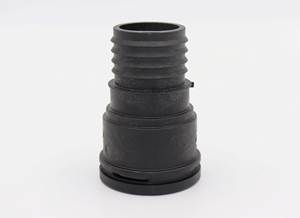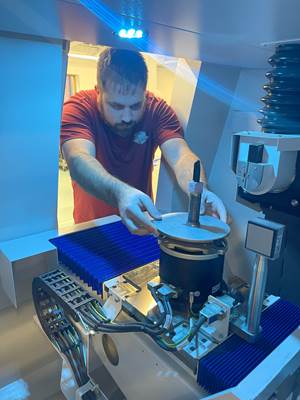Simulation Software: A Virtual Methods Testing Lab for New Opportunities
NC verification and simulation software has been available to manufacturers for more than 20 years, yet most NC programmers do not take full advantage of the benefits it can offer.
NC verification and simulation software has been available to manufacturers for more than 20 years, yet most NC programmers do not take full advantage of the benefits it can offer. However, some resourceful companies have discovered that simulation software can be used to benefit their shop in ways that others overlook—and in ways that may have even been unintended by the software developer!
One of the most obvious ways to get more from the software is to simply use it to try out new, unproven, machining strategies: as a virtual methods testing laboratory. Other than the time required to virtually create and test new methods, there is no physical cost. An NC programmer can try and adjust radical new ideas several times over. A few hours spent trying out different methods could potentially save many hours of machine time, reduce tool and machine wear, wasted materials, energy costs, and human fatigue as a result.
Users should always push their software to its limits. For example, a creative NC programmer for a large aerospace engine manufacturer was looking for a faster way to make the leading edge of a titanium fan blade, and the NC programmer theorized that a new machining method could make the difference they needed.
Traditionally the process for making the part took many hours using a grinding technique. The NC programmer believed the part could be created using a 5-axis mill, but he knew he would need to convince management before tying up the expensive machine for many hours cutting a test part. By using NC verification and simulation software to simulate the process, he was able to create a video to prove the process would work.
According to the Association For Manufacturing Technology, 5-axis mills and mill/turn machines have become increasing popular and for good reason. They enable the manufacturer to drastically reduce machining time and reduce the number of set-ups required to complete a job. Simulation software takes the fear out of programming a multi-axis machine. When a program can be simulated, from the same code that will be sent to the machine, there is no excuse for not taking full advantage of a 5-axis machine’s capabilities.
Moldmakers are increasingly turning to 5-axis machining to improve machining processes traditionally carried-out on 3-axis milling machines. But they usually have no experience or their experience is from aerospace machining, not mold machining. Thus new processes must be employed. Five-axis machine simulation software that accurately represents each 5-axis machining cut in great detail provides the confidence to succeed, while allowing for new invention, experimentation and success with new techniques.
Even today, with machine tool sales down more than 40 percent from last year, there is still considerable time between the date the machine is ordered and the date that it is installed and ready to create parts. With simulation software, the manufacturer can be ready to create parts on the first day the machine is installed.
Machine tool companies often supply their software partners with the CAD geometry for their machines long before the machine has shipped to their joint customers. This geometry can then be used to create a realistic virtual machine. The manufacturer can then be proving out programs. Customers can then discover, before the machine is delivered, that the configuration ordered will not work or is not efficient. By catching the machine specification mistake early, the customer is able to change the order before the machine is delivered.
The aerospace manufacturer working on the leading edge took the idea a step further. After proving the 5-axis milling process could work, they were ready to order production machines. Rather than simply picking the machine from a catalog, they designed the machine in their simulation software, where they had already proven the process would work. These files were then sent to the machine tool builder who built the machine exactly to their specifications as described in a virtual machining simulation.
There are always opportunities to improve an existing process, and simulation software can help by giving the NC programmer the freedom to try practically any machine technique in a virtual world. Only creativity is required.
Related Content
How to Harness 3D Scanning for Mold Tool Repairs
3D scanning supports the repair of molds with no history, drawings or design files.
Read MoreUsing CT Scanning to Qualify Molds Faster
Software and hardware advances reduce dimensional inspection with part-to-CAD by 70%.
Read MoreIt Starts With the Part: A Plastic Part Checklist Ensures Good Mold Design
All successful mold build projects start with examining the part to be molded to ensure it is moldable and will meet the customers' production objectives.
Read MoreHow to Select a Mold Temperature Controller
White paper shares how cooling channel analysis, which collects maximum pressure drop, total flow rate and heat dissipation, eases the performance evaluation of mold temperature controllers.
Read MoreRead Next
How to Use Strategic Planning Tools, Data to Manage the Human Side of Business
Q&A with Marion Wells, MMT EAB member and founder of Human Asset Management.
Read MoreHow to Use Continuing Education to Remain Competitive in Moldmaking
Continued training helps moldmakers make tooling decisions and properly use the latest cutting tool to efficiently machine high-quality molds.
Read MoreAre You a Moldmaker Considering 3D Printing? Consider the 3D Printing Workshop at NPE2024
Presentations will cover 3D printing for mold tooling, material innovation, product development, bridge production and full-scale, high-volume additive manufacturing.
Read More




















